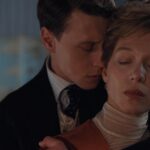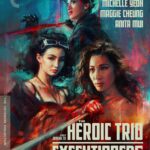I Saw the Light: All I Do Is Sit and Sigh, by David Bax
It’s only natural that someone making a biopic of a great cultural figure would want to avoid charges of hagiography. That’s why the phrase “warts and all” is generally applied as an accolade. Sometimes, though, filmmakers overcorrect. Marc Abraham’s I Saw the Light, about the short, bright career of country legend Hank Williams (played by Tom Hiddleston), is one of those, falling into the “Guess what? Turns out he was a piece of shit” category. And it’s not even compelling as that.
I Saw the Light, based on a Williams biography by Colin Escott, George Merritt and William MacEwen, isn’t much concerned with its subject’s childhood or teenage years. Instead, it begins with him scraping together a meager income from late night honky tonk performances and singing on the local radio to support his wife (Elizabeth Olsen) and mother (Cherry Jones). From there, we see his quick rise to prominence and the way his depression, alcoholism, painkiller addictions and general mean temper dismantled all of his relationships, from his multiple wives to his bandmates to his agents and managers. His fame persisted, though, because his talent was the only thing too big to be eclipsed by his demons. Then, at 29 years old, he died.
Things actually start quite promisingly, and not just because of the Executive Music Producer credit for Rodney Crowell in the opening titles. Abraham’s literal shining moment comes in the film’s very first sequence, a chronologically and narratively disconnected single shot that circles Williams as he stands under a bright white spotlight and sings on a stage in the round (Hiddleston’s own voice is used throughout). That solitary beam above his head is the only illumination, reducing Williams to a lanky, dark silhouette and a plaintive voice, the audience an eerie mass of silent, half-seen specters. It’s haunting but it’s sadly the last time Abraham will so effectively marry song and image.
After that, Abraham and cinematographer Dante Spinotti bafflingly subvert the film around them with oppressive close-ups that block out the terrific production design (by Meredith Boswell), art direction (by Rob Simons) and costumes (by Lahly Poore). The camera is perhaps intended to be subjective but the only emotion it translates is that of a voice shouting “SAD!” over and over again. The technique is as useless as the overly specific date and location markers that open every section. Actually, on second thought, those might serves a purpose, as the staging and editing are so muddled that it often feels like time is actually standing still.
The beats of the rise and fall story are so perfunctory, you could time cigarette breaks during a screening and be sure not to miss any of the musical performances. In the first act, we are introduced to all the people who helped Williams along so that we can be crushed when he betrays and forgets them. Then, Hiddleston and Olsen argue about drinking and womanizing as if they are merely hitting their marks. When we finally reach the pre-death scene, in which Hiddleston looks up at the camera from the backseat of a car, the framing suggesting a plea for redemption the character never voices, you will know to start gathering your things in order to beat the traffic on the way out.
Even good musician biopics, like Tate Taylor’s James Brown movie, Get On Up, from a couple years ago, can struggle to make a case that watching them will actually teach you more than you could learn by simply listening to the music itself. I Saw the Light is so dreary and punishing, it might actually discourage you from even doing that.




























